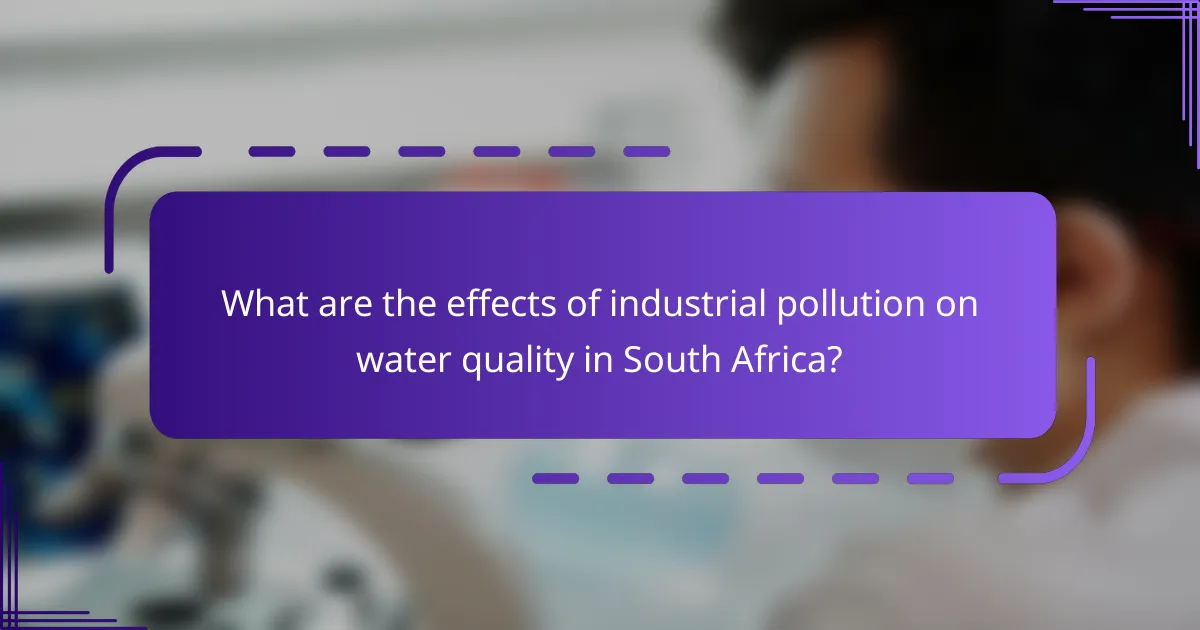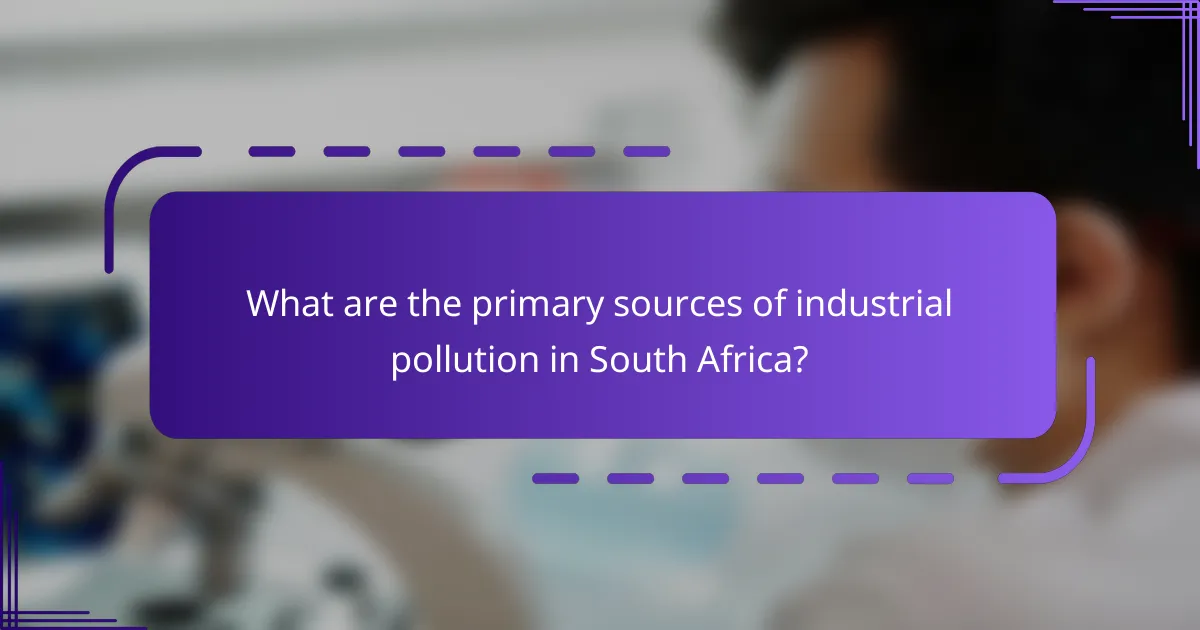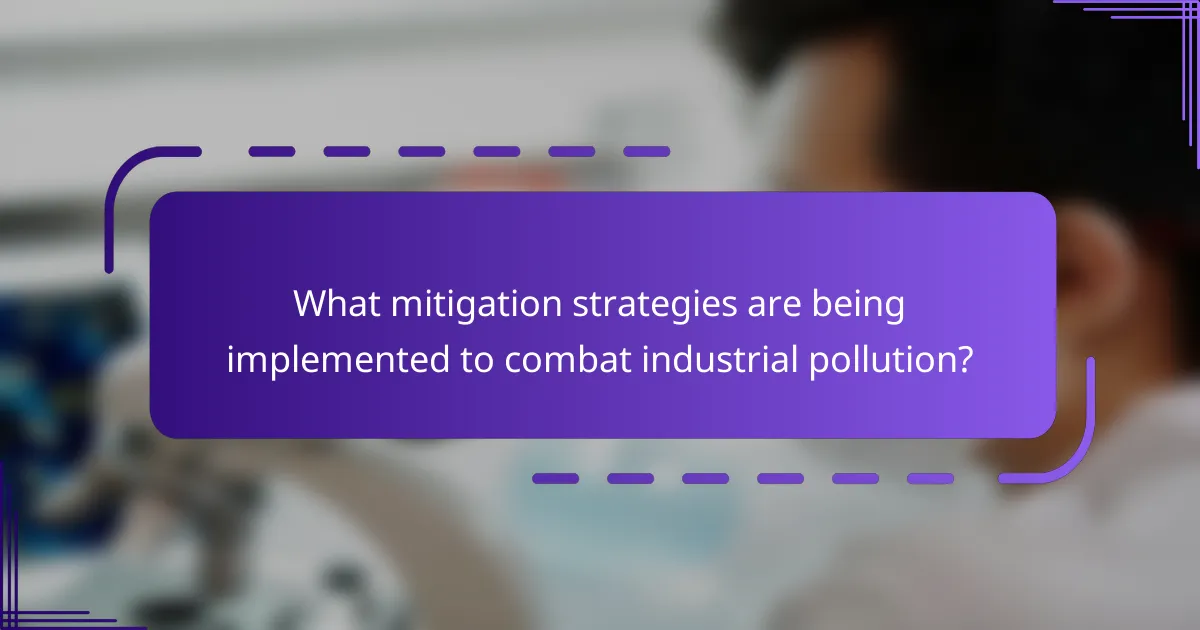Industrial pollution in South Africa is a critical issue affecting water quality, primarily caused by contaminants such as heavy metals and chemicals from mining, manufacturing, and energy production. These pollutants lead to toxic environments for aquatic life and pose significant health risks to communities reliant on contaminated water sources. Currently, 60% of South Africa’s rivers are polluted, highlighting the urgent need for regular monitoring and effective mitigation strategies. Efforts to combat this problem include regulatory measures, technological advancements in cleaner production, and community engagement initiatives aimed at reducing the environmental impact of industrial activities.

What are the effects of industrial pollution on water quality in South Africa?
Industrial pollution significantly deteriorates water quality in South Africa. Contaminants from industries, such as heavy metals and chemicals, enter water bodies. This leads to toxic environments for aquatic life. High levels of pollutants can cause eutrophication, depleting oxygen in water. The presence of harmful substances affects drinking water sources. Communities that rely on these sources face health risks. According to the Department of Water and Sanitation, 60% of rivers in South Africa are polluted. Regular monitoring is essential to manage and mitigate these effects.
How does industrial pollution impact aquatic ecosystems?
Industrial pollution adversely affects aquatic ecosystems. It introduces harmful substances such as heavy metals, chemicals, and toxins into water bodies. These pollutants can lead to reduced water quality and disrupt aquatic life. For example, heavy metals can accumulate in fish, impacting their health and reproduction. Nutrient pollution from industrial runoff can cause algal blooms, which deplete oxygen levels in the water. This process, known as eutrophication, results in dead zones where aquatic life cannot survive. Studies indicate that industrial activities are significant contributors to water pollution in regions like South Africa. The South African Water Quality Guidelines highlight the need for strict regulation to mitigate these impacts.
What specific pollutants are most harmful to water quality?
Heavy metals, nutrients, and pathogens are specific pollutants most harmful to water quality. Heavy metals like lead, mercury, and cadmium can accumulate in aquatic organisms. These metals can cause severe health issues in humans and wildlife. Nutrients, particularly nitrogen and phosphorus, can lead to eutrophication. Eutrophication results in algal blooms that deplete oxygen levels in water bodies. Pathogens such as bacteria and viruses can contaminate drinking water sources. This contamination poses significant health risks to populations relying on these water sources. Studies have shown that industrial activities are major contributors to these pollutants. For instance, mining operations often release heavy metals into nearby water systems.
How do these pollutants affect marine life and biodiversity?
Pollutants negatively impact marine life and biodiversity by disrupting ecosystems. Heavy metals, plastics, and chemicals accumulate in marine organisms. This accumulation leads to toxicity, affecting growth and reproduction. Studies show that pollutants can cause mutations in fish and reduce populations of sensitive species. Nutrient pollution results in algal blooms, which deplete oxygen levels. Low oxygen zones create dead zones, harming marine habitats. The decline in biodiversity affects food webs and ecosystem resilience. Research indicates that industrial pollutants significantly threaten marine species in South Africa’s waters.
What are the health implications of polluted water sources?
Polluted water sources pose significant health risks to humans. Contaminated water can transmit diseases such as cholera, dysentery, and typhoid fever. These illnesses arise from pathogens present in polluted water. In South Africa, industrial pollution often introduces heavy metals like lead and mercury into water supplies. Exposure to these metals can lead to long-term health issues, including neurological damage and developmental disorders. According to the World Health Organization, around 2 billion people globally use a drinking water source contaminated with feces. This statistic highlights the severity of the problem. Furthermore, the presence of chemical pollutants can cause skin irritations and respiratory problems upon exposure. The health implications of polluted water sources are vast and critical to public health.
How does industrial pollution lead to waterborne diseases?
Industrial pollution leads to waterborne diseases by contaminating water sources with harmful pathogens and chemicals. Factories often discharge untreated waste into rivers and lakes. This waste contains bacteria, viruses, and parasites. These pathogens can survive in water for extended periods. When people consume or come into contact with contaminated water, they are at risk of infection. According to the World Health Organization, waterborne diseases cause over 3 million deaths annually. In South Africa, industrial pollution significantly contributes to the prevalence of diseases like cholera and dysentery. Monitoring and regulation of industrial waste are crucial to prevent these health risks.
What populations are most at risk from contaminated water?
Populations most at risk from contaminated water include children, the elderly, and those with compromised immune systems. Children are particularly vulnerable due to their developing bodies and higher water intake relative to body weight. The elderly often have weakened immune systems, making them more susceptible to waterborne diseases. Individuals with chronic illnesses or weakened immune systems face increased health risks from contaminants. Low-income communities frequently lack access to clean water, exacerbating their risk. Rural populations may also be affected due to limited infrastructure for safe water supply. Studies indicate that these groups experience higher rates of illness related to contaminated water sources.

What are the primary sources of industrial pollution in South Africa?
The primary sources of industrial pollution in South Africa include mining activities, manufacturing processes, and energy production. Mining operations release heavy metals and toxic substances into nearby water bodies. Manufacturing industries emit pollutants such as volatile organic compounds and particulate matter. Energy production, particularly from coal-fired power plants, contributes significantly to air and water pollution through the discharge of sulfur dioxide and other contaminants. According to the Department of Environmental Affairs, mining and industrial activities are major contributors to the country’s pollution levels.
Which industries are the largest contributors to water pollution?
The largest contributors to water pollution are the agriculture, manufacturing, mining, and energy sectors. Agriculture contributes through runoff containing fertilizers, pesticides, and animal waste. Manufacturing industries discharge heavy metals and chemicals into water bodies. Mining operations release sediments and toxic substances, contaminating water sources. The energy sector, particularly coal and oil extraction, leads to oil spills and thermal pollution. Statistics indicate that these industries account for significant percentages of water pollution in South Africa. For instance, the agricultural sector is responsible for approximately 60% of water pollution in the country.
How does mining contribute to water quality degradation?
Mining contributes to water quality degradation primarily through the release of pollutants. This activity often involves the excavation of minerals, which disturbs the land and exposes harmful substances. Heavy metals such as lead, mercury, and arsenic can leach into nearby water sources. Additionally, mining processes generate waste materials that may contain toxic chemicals. Runoff from mining sites can carry these pollutants into rivers and lakes. Research indicates that mining operations significantly increase sedimentation in water bodies. Sedimentation can harm aquatic ecosystems and reduce water clarity. The South African Department of Water and Sanitation reported that mining activities are a major source of water contamination in the region. Such degradation poses risks to human health and the environment.
What role does manufacturing play in water pollution?
Manufacturing significantly contributes to water pollution. Industrial processes often release harmful chemicals and waste into water bodies. This includes heavy metals, solvents, and other toxic substances. According to the South African Department of Water and Sanitation, industries are responsible for a substantial portion of water quality degradation. For instance, mining and manufacturing sectors are major sources of pollutants in rivers. These pollutants can lead to serious health issues for humans and ecosystems. Additionally, improper waste management practices exacerbate the problem. Thus, manufacturing plays a critical role in the ongoing challenge of water pollution in South Africa.
What are the geographical hotspots for industrial pollution in South Africa?
The geographical hotspots for industrial pollution in South Africa include the Vaal Triangle, Johannesburg, and Durban. The Vaal Triangle is heavily industrialized and is known for high emissions from factories. Johannesburg has numerous mining and industrial activities contributing to air and water pollution. Durban, with its large port and petrochemical industries, also faces significant pollution challenges. These areas have been identified in various studies, including the South African National Environmental Management Act reports, which highlight the impact of industrial activities on air and water quality.
How do urban areas compare to rural areas in terms of pollution levels?
Urban areas generally have higher pollution levels compared to rural areas. This is due to concentrated industrial activities, vehicular emissions, and higher population densities. According to the World Health Organization, urban areas can have particulate matter levels exceeding recommended limits. In contrast, rural areas often benefit from lower traffic and fewer industrial sources. Studies show that rural air quality can be significantly better, with lower concentrations of nitrogen dioxide and sulfur dioxide. For instance, a study in South Africa found that urban Johannesburg had pollution levels three times higher than rural regions. Urban pollution also impacts water quality through runoff, which is less prevalent in rural settings.
What regions are most affected by industrial runoff?
The regions most affected by industrial runoff in South Africa include the Vaal River Basin and the Olifants River Basin. These areas experience significant pollution due to nearby industrial activities. The Vaal River Basin is home to numerous factories and mines, leading to high levels of contaminants in the water. The Olifants River Basin is similarly impacted by mining and agricultural runoff. Studies have shown that these regions face serious water quality issues. For example, the Vaal River has been classified as severely polluted, affecting both ecosystems and communities.

What mitigation strategies are being implemented to combat industrial pollution?
Mitigation strategies being implemented to combat industrial pollution include regulatory measures, technological advancements, and community engagement. Regulatory measures involve stricter emissions standards set by governments. These standards require industries to reduce pollutants released into the environment. Technological advancements focus on cleaner production techniques and waste treatment processes. For example, many industries are adopting scrubbers and filters to capture harmful emissions. Community engagement initiatives involve educating the public and stakeholders about pollution impacts. These initiatives encourage local participation in monitoring and reporting pollution incidents. Collaboration between industries and environmental organizations also plays a crucial role in developing effective strategies. Collectively, these efforts aim to minimize the environmental impact of industrial activities.
How effective are current regulations in reducing water pollution?
Current regulations are moderately effective in reducing water pollution. South Africa has implemented laws like the National Water Act and the National Environmental Management Act. These regulations aim to control industrial discharges into water bodies. However, enforcement remains inconsistent across regions. A study by the South African Water Research Commission found that compliance rates are below 50% for many industries. This lack of adherence limits the overall effectiveness of the regulations. Additionally, monitoring systems are often inadequate, leading to unreported pollution incidents. Therefore, while regulations exist, their impact is diminished by enforcement challenges and monitoring gaps.
What laws govern industrial discharges into water bodies?
The laws governing industrial discharges into water bodies in South Africa include the National Water Act of 1998 and the Water Quality Management Policy. The National Water Act regulates the use of water resources and establishes a framework for water quality management. This act requires industries to obtain water use licenses that specify permissible discharge limits. The Water Quality Management Policy outlines standards for water quality and sets objectives for managing pollution. Compliance with these laws is enforced by the Department of Water and Sanitation. Violations can result in penalties and legal action. These regulations aim to protect water resources and ensure sustainable management.
How are enforcement mechanisms structured in South Africa?
Enforcement mechanisms in South Africa are structured through various regulatory bodies and legislation. The Department of Environmental Affairs oversees environmental protection and compliance. The National Environmental Management Act provides the legal framework for enforcement actions. Local municipalities also play a role in monitoring industrial activities. Compliance assessments are conducted to ensure adherence to environmental standards. Penalties for non-compliance can include fines and operational restrictions. The enforcement structure aims to protect water quality from industrial pollution. These mechanisms are crucial for sustainable environmental management in South Africa.
What innovative technologies are being used for pollution control?
Innovative technologies for pollution control include advanced filtration systems, bioremediation, and air scrubbing technologies. Advanced filtration systems use membranes to remove contaminants from water. Bioremediation employs microorganisms to degrade pollutants in soil and water. Air scrubbing technologies capture airborne pollutants using chemical processes. These technologies enhance water and air quality effectively. For instance, membrane filtration can achieve over 90% removal of certain contaminants. Bioremediation has been shown to reduce hazardous waste by up to 70%. Air scrubbing systems can significantly lower emissions from industrial sources.
How do wastewater treatment plants improve water quality?
Wastewater treatment plants improve water quality by removing contaminants from sewage and industrial waste. They employ processes such as screening, sedimentation, and biological treatment. Screening removes large debris, preventing damage to equipment. Sedimentation allows solids to settle, separating them from the water. Biological treatment uses microorganisms to break down organic matter. Advanced treatments, like filtration and disinfection, further enhance water quality. According to the U.S. Environmental Protection Agency, effective wastewater treatment can remove up to 99% of pollutants. This results in cleaner water that is safer for ecosystems and human use.
What role does bioremediation play in mitigating pollution effects?
Bioremediation plays a crucial role in mitigating pollution effects by utilizing microorganisms to degrade contaminants. This process effectively reduces harmful substances in polluted environments, particularly in water bodies. For instance, bioremediation can target heavy metals, hydrocarbons, and pesticides. Studies show that specific bacteria can break down these pollutants into less toxic forms. In South Africa, bioremediation has been applied to restore water quality affected by industrial activities. The use of native microbial strains enhances the efficiency of bioremediation efforts. This method is cost-effective and environmentally friendly compared to traditional remediation techniques. Overall, bioremediation significantly contributes to restoring ecosystems impacted by industrial pollution.
What community actions can help address industrial water pollution?
Community actions to address industrial water pollution include organizing clean-up initiatives and advocating for stricter regulations. Local groups can conduct regular water quality monitoring to identify pollution sources. Education campaigns raise awareness about the impacts of industrial waste on water systems. Community members can engage in dialogues with local industries to promote sustainable practices. Collaborating with environmental organizations can amplify efforts to reduce pollution. Implementing rainwater harvesting can decrease dependency on polluted sources. Supporting policies that enforce penalties for violators enhances accountability. These actions contribute to healthier water ecosystems and community well-being.
How can local communities engage in monitoring water quality?
Local communities can engage in monitoring water quality by forming volunteer groups to collect water samples. These groups can use simple testing kits to measure parameters like pH, turbidity, and contaminants. Regular training sessions can enhance their skills in sample collection and analysis. Collaborating with local universities can provide access to advanced testing methods and expertise. Communities can also establish reporting systems to share findings with local authorities. Engaging in awareness campaigns can educate residents about the importance of water quality. This grassroots involvement fosters a sense of responsibility and empowerment in protecting local water resources. Studies indicate that community-led monitoring can effectively complement government efforts in ensuring water safety.
What are best practices for reducing industrial waste at the source?
Best practices for reducing industrial waste at the source include implementing waste minimization techniques. These techniques focus on reducing the volume and toxicity of waste generated during production. Companies can adopt cleaner production methods, which emphasize efficiency and sustainability. Utilizing materials that produce less waste is also crucial. Regular audits can identify areas for improvement in waste generation. Employee training enhances awareness and encourages waste reduction practices. Collaboration with suppliers can lead to more sustainable sourcing options. Additionally, investing in technology that reduces waste can yield significant benefits. These practices not only reduce waste but also improve operational efficiency and lower costs.
The main entity of this article is industrial pollution and its effects on water quality in South Africa. The article examines how industrial activities contribute to water contamination through pollutants like heavy metals, chemicals, and pathogens, significantly impacting aquatic ecosystems and human health. It highlights the primary sources of pollution, including mining, manufacturing, and agriculture, as well as the health risks associated with polluted water sources. Additionally, the article discusses mitigation strategies, regulatory frameworks, and community actions aimed at addressing industrial pollution and improving water quality.